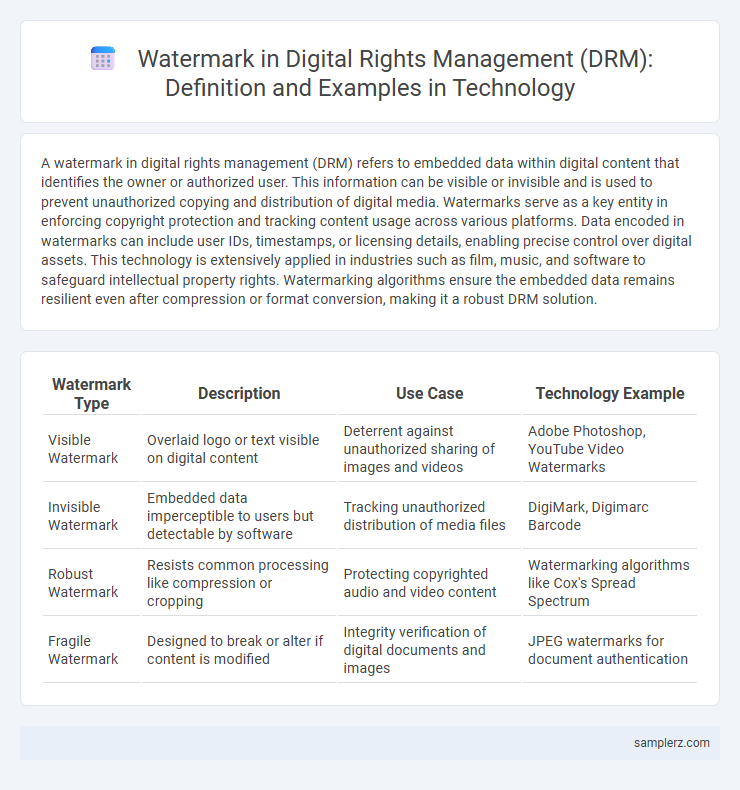A watermark in digital rights management (DRM) refers to embedded data within digital content that identifies the owner or authorized user. This information can be visible or invisible and is used to prevent unauthorized copying and distribution of digital media. Watermarks serve as a key entity in enforcing copyright protection and tracking content usage across various platforms. Data encoded in watermarks can include user IDs, timestamps, or licensing details, enabling precise control over digital assets. This technology is extensively applied in industries such as film, music, and software to safeguard intellectual property rights. Watermarking algorithms ensure the embedded data remains resilient even after compression or format conversion, making it a robust DRM solution.
Table of Comparison
| Watermark Type | Description | Use Case | Technology Example |
|---|---|---|---|
| Visible Watermark | Overlaid logo or text visible on digital content | Deterrent against unauthorized sharing of images and videos | Adobe Photoshop, YouTube Video Watermarks |
| Invisible Watermark | Embedded data imperceptible to users but detectable by software | Tracking unauthorized distribution of media files | DigiMark, Digimarc Barcode |
| Robust Watermark | Resists common processing like compression or cropping | Protecting copyrighted audio and video content | Watermarking algorithms like Cox's Spread Spectrum |
| Fragile Watermark | Designed to break or alter if content is modified | Integrity verification of digital documents and images | JPEG watermarks for document authentication |
Introduction to Watermarking in Digital Rights Management
Watermarking in digital rights management embeds imperceptible information into multimedia content to protect intellectual property and verify ownership. This technique utilizes robust algorithms to ensure the watermark remains detectable even after compression, resizing, or format conversion. Common examples include invisible logos or user-specific codes integrated into images, videos, and audio files to prevent unauthorized distribution.
Role of Watermarks in Protecting Digital Content
Watermarks embed invisible or visible identifiers within digital content, enabling traceability and ownership verification essential for digital rights management (DRM). This technique deters unauthorized distribution by linking leaked content to the original source, facilitating enforcement actions against infringement. Advanced watermarking methods enhance content security without compromising user experience, ensuring robust protection across multimedia platforms.
Types of Watermarks in DRM Systems
Visible watermarks are semi-transparent logos or text embedded directly onto digital content to deter unauthorized use. Invisible watermarks, often imperceptible to the human eye, encode ownership details or usage rights within the data, facilitating traceability and copyright enforcement. Robust watermarks resist removal or distortion through common modifications like resizing, cropping, or compression, ensuring persistent protection in digital rights management systems.
Invisible vs. Visible Watermarks: Key Differences
Invisible watermarks in digital rights management embed imperceptible data within multimedia files, ensuring copyright protection without altering user experience. Visible watermarks display logos or text overlays, making ownership immediately identifiable but potentially distracting from content. The key difference lies in visibility: invisible watermarks prioritize stealth and authentication, while visible watermarks emphasize deterrence and brand recognition.
Audio Watermarking: Securing Music and Podcasts
Audio watermarking embeds inaudible signals within music tracks and podcasts to protect intellectual property rights. Techniques like spread-spectrum and echo hiding ensure the watermark remains resilient against common audio processing and compression. This method enables precise tracking of unauthorized distribution while preserving audio quality for legitimate listeners.
Video Watermarking: Safeguarding Streaming Content
Video watermarking embeds imperceptible digital marks within streaming content to deter unauthorized distribution and ensure copyright protection. Techniques like spatial and frequency domain watermarking enhance the robustness and invisibility of watermarks, maintaining video quality while enabling traceability. Leading platforms such as Netflix and Hulu employ these methods to safeguard intellectual property and monitor piracy in real-time.
Image Watermarking Techniques in DRM
Image watermarking techniques in digital rights management embed imperceptible data within images to protect copyright and verify authenticity. Methods such as spatial domain watermarking alter pixel values directly, while frequency domain techniques, like discrete cosine transform (DCT) and discrete wavelet transform (DWT), embed watermarks in transformed image coefficients for increased robustness. These techniques enable tracking unauthorized distribution and ensuring secure image usage across digital platforms.
Text Document Watermarking Methods
Text document watermarking methods in digital rights management include visible watermarks, which embed transparent text or logos directly onto pages, ensuring immediate document identification. Invisible techniques utilize altering character spacing, font variations, or zero-width spaces to embed proprietary information without affecting readability. Robust algorithms like spread spectrum and linguistic watermarking enable tamper detection and content tracing while preserving document integrity.
Real-World Examples of Watermark Usage in DRM
Netflix employs forensic watermarking technology in its DRM strategy to trace unauthorized content distribution by embedding unique, invisible markers in each streaming copy. Amazon Prime Video integrates watermarking to identify and prevent piracy by linking pirated videos back to specific user accounts. Apple's FairPlay DRM utilizes watermarking techniques to protect digital music and video content, ensuring traceability and reducing illegal sharing on their platforms.
Future Trends in Watermarking for Digital Rights Protection
Emerging trends in watermarking for digital rights protection emphasize robust, imperceptible, and self-healing watermarks that adapt to evolving cyber threats. Integration of AI-driven algorithms enhances the detection and authentication processes, ensuring real-time monitoring of copyrighted content across diverse platforms. Quantum-resistant watermarking techniques and blockchain-based verification systems are poised to revolutionize the digital rights management landscape.

example of watermark in digital rights management Infographic
 samplerz.com
samplerz.com